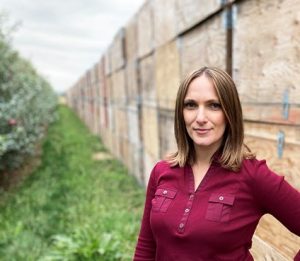
Written by Tianna DuPont, Cody Molnar WSU Extension. updated August 11, 2022.
Sampling and removal of infected trees is critical to slowing the current outbreak of Western X and Little Cherry Virus. Infected trees can not be cured. The disease is spread throughout the tree even when symptoms are obvious only in one section. Infected trees must be removed. Any infected trees that remain in the orchard are a reservoir of disease for your orchard and your neighbor’s.
Little Cherry Disease is caused by Little Cherry Virus 1 and 2 and X-disease is caused by X-disease phytoplasma. In addition to insect vectors, root grafting can move the diseases from tree to tree and threaten new infections in replacement trees.
Before removing infected trees treat with insecticide so that leafhopper/ mealy bug vectors do not move to uninfected trees.
It is recommended to apply glyphosate herbicide to trees at the time of tree removal or test adjoining trees to detect latent infections early. Herbicide application can also help kill roots of infected trees so that they can no longer infect new roots via root grafting.

Treat the interface of the bark with the wood, the area called the cambium or sapwood (the outer ring of wood, next to and including the bark) (Figure 1). This is the living part of the tree which moves water and nutrients and will be most likely to move the herbicide. Treat when the tree is actively growing. Herbicide must be applied immediately after cutting.
Multiple glyphosate labels allow application in stone fruit and as a ‘cut stump treatment’ (eg Glystar pg 29, Buccaneer pg 24). Check your glyphosate label. Most labels say to apply a 50 (mixed with water) to 100% solution of the glyphosate product. Applications can be made with a small hand/backsprayer or a paint brush to fully cover the entire cambium (Figure 2). Some labels also allow a frill/injection application (eg Glyphosate 4DS pg 28) (Figure 3). A hatchet, chainsaw or drill can be used to notch the tree.
Tree Removal Trials
In 2019 and 2020 four replicated trials were conducted to identify rates, timing, method and efficacy of herbicide application when used for tree removal of X-disease or Little Cherry Virus infected trees. Results from these initial trials found that:
- August and May applications can result in root death. September timings did not result in root death in the year of application.
- Frill applications performed best across trials. Cut stump applications were slightly less effective.
- Glyphosate may need to be more than 1 oz per tree (assuming 30 in tree circumference).
- Herbicide applications during tree removal resulted in tree injury of adjoining trees in Mazzard rootstocks with a large rooting area but not smaller Gisela 12. Herbicide applications are most important on large (Mazzard) type rootstocks.
Summary
Removal of infected trees is critical to successful management of this disease. Be aggressive.
- Scout and mark suspect trees.
- Sample trees if X-disease/ Little cherry disease is NOT confirmed in block or symptoms are not clear.
- Remove symptomatic/positive trees.
-
- Treat insect vectors before removal.
- Use glyphosate herbicide applied via cut stump/ notch or sample 1 tree out from symptomatic trees.
- Remove adjacent trees with herbicide injury/positive results.
- If more than 20% positive consider removing entire block.
For more information
Tree Removal Methods for X-Disease and Little Cherry Disease- Preliminary Trial Report
DuPont, S.T., Strohm, C., Molnar, C., Naranjo, R., Bishop, G., Case studies on tree removal for X-disease phytoplasma and Little cherry virus. Fruit Matters. August 8, 2020.
X-disease Phytoplasma (Western X)
X-disease and Little Cherry Virus Scouting and Sampling Guide
Little Cherry Disease Eligible for Tree Assistance Program
Contacts
 Tianna DuPont
Tianna DuPont
WSU Extension Regional Specialist
tianna.dupont@wsu.edu
(509) 293-8758
 Corina Serban
Corina Serban
WSU ITT Extension
(509) 574-1600
Scott Harper, Department of Plant Pathology, Washington State University, 509-786-9230 or scott.harper@wsu.edu
Bernardita Sallato, WSU Extension (509) 439-8542 b.sallato@wsu.edu
Ashley Thomson, OSU Extension (541) 296-5494 Ashley.Thompson@oregonstate.edu
Karen Lewis, WSU Extension (509) 760-2263 kmlewis@wsu.edu
Fruit Matters articles may only be republished with prior author permission © Washington State University. Reprint articles with permission must include: Originally published by Washington State Tree Fruit Extension Fruit Matters at treefruit.wsu.edu and a link to the original article.
